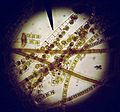Green algae facts for kids
Quick facts for kids Green algae |
|
|---|---|
 |
|
| Scientific classification | |
| Kingdom: | |
| Divisions | |
Green algae are tiny living things, often too small to see without a microscope. They are a type of protist, which are simple organisms that are not animals, plants, or fungi. You can find green algae almost everywhere there's water: in salt water like oceans, in freshwater like lakes and rivers, and even in brackish water, which is a mix of fresh and salt water.
Green algae are a very important group because scientists believe that all the plants we see on land today, from tiny mosses to giant trees, grew from ancient green algae.
Contents
What Are Green Algae Like?
Green algae come in many shapes and sizes. Some are just a single cell, while others live together in groups called colonies. Many green algae cells have two tiny, whip-like tails called flagella. They use these flagella to swim around in the water.
Besides single cells and colonies, green algae can also form different shapes. Some are round like tiny balls (called coccoid forms), and others grow in long, thin strands like threads (called filamentous forms). There are about 6,000 different kinds of green algae known to science!
Green Algae and Land Plants
The green algae are a very large group of algae. They are special because they are the ancestors of all the higher plants that grow on land. This means that millions of years ago, some green algae started to adapt to life outside of water, eventually leading to the huge variety of plants we see today.
One group of green algae, called the Charales, are the closest relatives to land plants. These algae are quite complex and can even show different parts that act like tissues, similar to how plants have different parts like roots and leaves.
Related Pages
- Algae
- Brown algae
- Euglena, a protist that includes a green alga within its cells
- Seaweed
Images for kids
-
A growth of the green seaweed Ulva on rock substratum at the ocean shore. Some green seaweeds like Ulva are quick to utilize inorganic nutrients from land runoff, and thus can be indicators of nutrient pollution.
See also
 In Spanish: Alga verde para niños
In Spanish: Alga verde para niños



